Space Efficiency in European High-Rise Timber Buildings
Abstract
1. Introduction
2. Methods
3. Results
3.1. Key Architectural Considerations: Function, Core Planning, and Building Form
- Stability against sideways pressures, lessening requirements for reinforcement.
- Augmented available area by concentrating vital amenities.
- Increased effectiveness via reduced circulation lengths and simplified entryways.
- Elevated daylight and vistas owing to expanded window areas.
- Versatility for forthcoming adjustments requiring minimal structural alterations.
- Economies achieved via enhanced structural effectiveness.
- Liberty in façade design as the core structure bears the primary load.
- Reinforced fire safety with fire-retardant zones.
3.2. Key Structural Considerations: Material and System
3.3. Space Efficiency
3.3.1. Inter-Relationship of Space Efficiency and Function
3.3.2. Inter-Relationship of Space Efficiency and Core Planning
3.3.3. Inter-relationship of Space Efficiency and Form
3.3.4. Inter-Relationship of Space Efficiency and Structural Material
3.3.5. Inter-Relationship of Space Efficiency and Structural System
4. Discussion
5. Conclusions
- Residential use is the top choice in Europe. Central core designs are the most common, showing a liking for structures with a strong and stable center. Prismatic shapes are favored, indicating a preference for smooth and simple architectural styles.
- A significant trend is the extensive use of composite construction, primarily combining timber and concrete. Structural systems used often favor shear-frame designs, particularly shear-walled frames, underscoring a dedication to strong structural solutions among European high-rise towers.
- The average space efficiency observed in the analyzed towers was noted at 82%, with fluctuations spanning from 70% to 90% among various cases.
- The average core area to GFA ratio was 11%, indicating differences between 4% and 21%.
Author Contributions
Funding
Institutional Review Board Statement
Informed Consent Statement
Data Availability Statement
Conflicts of Interest
Appendix A
| # | Building Name | Country | City | Height (m) | # of Stories | Completion Date | Function |
|---|---|---|---|---|---|---|---|
| 1 | Mjøstårnet | Norway | Brumunddal | 85 | 18 | 2019 | M(R + O + H) |
| 2 | HoHo Wien | Austria | Vienna | 84 | 23 | 2020 | M(R + O + H) |
| 3 | TRAE | Denmark | Aarhus | 82 | 20 | UC | Office |
| 4 | HAUT | Netherlands | Amsterdam | 73 | 22 | 2022 | Residential |
| 5 | Sara Kulturhus | Sweden | Skellefteå | 73 | 20 | 2021 | Hotel |
| 6 | De Karel Doorman | Netherlands | Rotterdam | 71 | 22 | 2012 | Residential |
| 7 | Roots Tower | Germany | Hamburg | 65 | 19 | UC | Residential |
| 8 | Abro (Baufeld 1 Suurstoffi Campus) | Switzerland | Risch-Rotkreuz | 60 | 15 | 2019 | Office |
| 9 | Hyperion | France | Bordeaux | 55 | 16 | 2021 | Residential |
| 10 | Rundeskogen Hus B | Norway | Sandnes | 55 | 16 | 2013 | Residential |
| 11 | Treet | Norway | Bergen | 49 | 14 | 2015 | Residential |
| 12 | Lighthouse Joensuu | Finland | Joensuu | 48 | 14 | 2019 | Residential |
| 13 | Cederhusen | Sweden | Stockholm | 44 | 13 | UC | Residential |
| 14 | Hoas Tuuliniitty | Finland | Espoo | 44 | 13 | 2021 | Residential |
| 15 | Palazzo Nice Meridia | France | Nice | 44 | 10 | 2019 | Office |
| 16 | Spor X | Norway | Drammen | 41 | 10 | 2021 | Office |
| 17 | Sensations | France | Strasbourg | 38 | 11 | 2019 | Residential |
| 18 | Rundeskogen Hus C | Norway | Sandnes | 38 | 11 | 2013 | Residential |
| 19 | Fyrtornet | Sweden | Malmö | 38 | 11 | UC | M(R+O) |
| 20 | Trafalgar Place | UK | London | 36 | 10 | 2015 | Residential |
| 21 | Suurstoffi 22 | Switzerland | Risch-Rotkreuz | 36 | 10 | 2018 | Office |
| 22 | Opalia | France | Saint-Ouen-sur-Seine | 35 | 8 | 2017 | Office |
| 23 | Green Office ENJOY | France | Paris | 35 | 8 | 2018 | Office |
| 24 | Pont de Flandres Batiment 007 | France | Paris | 35 | 8 | 2019 | Office |
| 25 | Hotel Jakarta | Netherlands | Amsterdam | 34 | 9 | 2018 | Hotel |
| 26 | Kringsja Studentby | Norway | Oslo | 34 | 10 | 2018 | Residential |
| 27 | Rundeskogen Hus A | Norway | Sandnes | 34 | 10 | 2012 | Residential |
| 28 | SKAIO | Germany | Heilbronn | 34 | 10 | 2019 | Residential |
| 29 | Dalston Works | UK | London | 34 | 10 | 2017 | Residential |
| 30 | The Cube Building | UK | London | 33 | 10 | 2015 | Residential |
| 31 | Botanikern | Sweden | Uppsala | 31 | 9 | 2019 | Residential |
| 32 | Cenni di Cambiamento | Italy | Milan | 31 | 9 | 2013 | Residential |
| 33 | Kajstaden | Sweden | Vasteras | 31 | 9 | 2019 | Residential |
| 34 | Press House | UK | London | 31 | 9 | 2017 | Residential |
| 35 | Vallen | Sweden | Vaxjo | 31 | 9 | 2015 | Residential |
| 36 | Timber Pioneer | Germany | Frankfurt am Main | 30 | 8 | UC | Office |
| 37 | Stadthaus | UK | London | 29 | 9 | 2009 | Residential |
| 38 | EDGE Suedkreuz | Germany | Berlin | 29 | 8 | 2022 | Office |
| 39 | Moholt 50/50 | Norway | Trondheim | 28 | 9 | 2016 | Residential |
| 40 | Cirerers | Spain | Barcelona | 27 | 8 | 2022 | Residential |
| 41 | DAS Kelo | Finland | Rovaniemi | 27 | 8 | 2019 | Residential |
| 42 | Docenten | Sweden | Vaxjo | 27 | 8 | 2018 | Residential |
| 43 | Dramsvegen | Norway | Tromso | 27 | 8 | 2017 | Residential |
| 44 | Frostaliden | Sweden | Skövde | 27 | 8 | 2018 | Residential |
| 45 | Highpoint Terrace | UK | London | 27 | 8 | 2017 | Residential |
| 46 | Jo & Joe | France | Gentilly | 27 | 8 | 2019 | Residential |
| 47 | Limnologen | Sweden | Vaxjo | 27 | 8 | 2014 | Residential |
| 48 | Maskinparken TRE | Norway | Trondheim | 27 | 8 | 2018 | Residential |
| 49 | Puukuokka Housing Block | Finland | Jyvaskyla | 27 | 8 | 2018 | Residential |
| 50 | Residences J.Ferry | France | Saint-Dié-des Vosges | 27 | 8 | 2014 | Residential |
| 51 | Strandparken | Sweden | Stockholm | 27 | 8 | 2014 | Residential |
| 52 | Trummens Strand | Sweden | Vaxjo | 27 | 8 | 2019 | Residential |
| 53 | Wood City Residential Buildings | Finland | Helsinki | 27 | 8 | 2018 | Residential |
| 54 | Lucien Cornil Student Residence | France | Marseille | 27 | 8 | 2017 | Residential |
| 55 | Pentagon I | Norway | As | 27 | 8 | 2013 | Residential |
| 56 | Bridport House | UK | London | 27 | 8 | 2010 | Residential |
Appendix B
| # | Building Name | Building Form | Core Type | Structural System | Structural Material |
|---|---|---|---|---|---|
| 1 | Mjøstårnet | Prismatic | Peripheral | Trussed-tube | Timber |
| 2 | HoHo Wien | Prismatic | Central | Shear walled frame | Composite (T + C) |
| 3 | TRAE | Prismatic | Central | Shear walled frame | Composite (T + C) |
| 4 | HAUT | Free | Peripheral | Shear walled frame | Composite (T + C) |
| 5 | Sara Kulturhus | Prismatic | Peripheral | Shear wall | Composite (T + S) |
| 6 | De Karel Doorman | Prismatic | Peripheral | Shear walled frame | Composite (T + C+S) |
| 7 | Roots Tower | Prismatic | Central | Shear walled frame | Composite (T + C) |
| 8 | Abro (Baufeld 1 Suurstoffi Campus) | Prismatic | Central | Shear walled frame | Composite (T + C) |
| 9 | Hyperion | Free | Central | Shear walled frame | Composite (T + C + S) |
| 10 | Rundeskogen Hus B | Free | Central | Shear walled frame | Composite (T + C) |
| 11 | Treet | Prismatic | Peripheral | Trussed-tube | Timber |
| 12 | Lighthouse Joensuu | Prismatic | Central | Shear wall | Timber |
| 13 | Cederhusen | Prismatic | Central | Shear wall | Timber |
| 14 | Hoas Tuuliniitty | Prismatic | Peripheral | Shear wall | Timber |
| 15 | Palazzo Nice Meridia | Prismatic | Peripheral | Shear walled frame | Composite (T + C) |
| 16 | Spor X | Prismatic | Central | Shear walled frame | Timber |
| 17 | Sensations | Free | Central | Shear walled frame | Timber |
| 18 | Rundeskogen Hus C | Free | Central | Shear walled frame | Composite (T + C) |
| 19 | Fyrtornet | Tapered | Central | Trussed-tube | Timber |
| 20 | Trafalgar Place | Prismatic | Peripheral | Shear wall | Timber |
| 21 | Suurstoffi 22 | Prismatic | Central | Shear walled frame | Composite (T + C) |
| 22 | Opalia | Prismatic | Peripheral | Shear walled frame | Composite (T + C + S) |
| 23 | Green Office ENJOY | Prismatic | Central | Shear walled frame | Composite (T + C) |
| 24 | Pont de Flandres Batiment 007 | Free | Central | Shear walled frame | Composite (T + C + S) |
| 25 | Hotel Jakarta | Prismatic | Central | Shear walled frame | Composite (T + C) |
| 26 | Kringsja Studentby | Prismatic | Central | Shear walled frame | Timber |
| 27 | Rundeskogen Hus A | Free | Central | Shear walled frame | Composite (T + C) |
| 28 | SKAIO | Prismatic | Central | Shear walled frame | Composite (T + C) |
| 29 | Dalston Works | Prismatic | Central | Shear wall | Timber |
| 30 | The Cube Building | Free | Central | Shear walled frame | Composite (T + C + S) |
| 31 | Botanikern | Prismatic | Peripheral | Shear trussed frame | Timber |
| 32 | Cenni di Cambiamento | Free | Central | Shear wall | Timber |
| 33 | Kajstaden | Prismatic | Peripheral | Shear wall | Timber |
| 34 | Press House | Prismatic | Central | Shear walled frame | Timber |
| 35 | Vallen | Prismatic | Central | Shear walled frame | Composite (T + C) |
| 36 | Timber Pioneer | Prismatic | Peripheral | Shear walled frame | Composite (T + C) |
| 37 | Stadthaus | Prismatic | Central | Shear wall | Timber |
| 38 | EDGE Suedkreuz | Prismatic | Central | Shear walled frame | Composite (T + C) |
| 39 | Moholt 50/50 | Prismatic | Central | Shear wall | Timber |
| 40 | Cirerers | Free | Peripheral | Shear wall | Timber |
| 41 | DAS Kelo | Prismatic | Peripheral | Shear walled frame | Timber |
| 42 | Docenten | Prismatic | Peripheral | Shear wall | Composite (T + C) |
| 43 | Dramsvegen | Prismatic | Peripheral | Shear wall | Composite (T + C) |
| 44 | Frostaliden | Prismatic | Central | Shear walled frame | Composite (T + C) |
| 45 | Highpoint Terrace | Prismatic | Peripheral | Shear wall | Timber |
| 46 | Jo & Joe | Prismatic | Peripheral | Shear walled frame | Composite (T + C) |
| 47 | Limnologen | Prismatic | Central | Shear wall | Composite (T + C + S) |
| 48 | Maskinparken TRE | Prismatic | Central | Shear wall | Timber |
| 49 | Puukuokka Housing Block | Prismatic | Central | Shear walled frame | Timber |
| 50 | Residences J.Ferry | Prismatic | Peripheral | Shear walled frame | Timber |
| 51 | Strandparken | Prismatic | Peripheral | Shear wall | Composite (T + S) |
| 52 | Trummens Strand | Prismatic | Peripheral | Shear wall | Timber |
| 53 | Wood City Residential Buildings | Prismatic | Peripheral | Shear walled frame | Timber |
| 54 | Lucien Cornil Student Residence | Prismatic | Peripheral | Shear walled frame | Composite (T + C) |
| 55 | Pentagon I | Prismatic | Central | Shear wall | Timber |
| 56 | Bridport House | Prismatic | Peripheral | Shear wall | Timber |
Appendix C
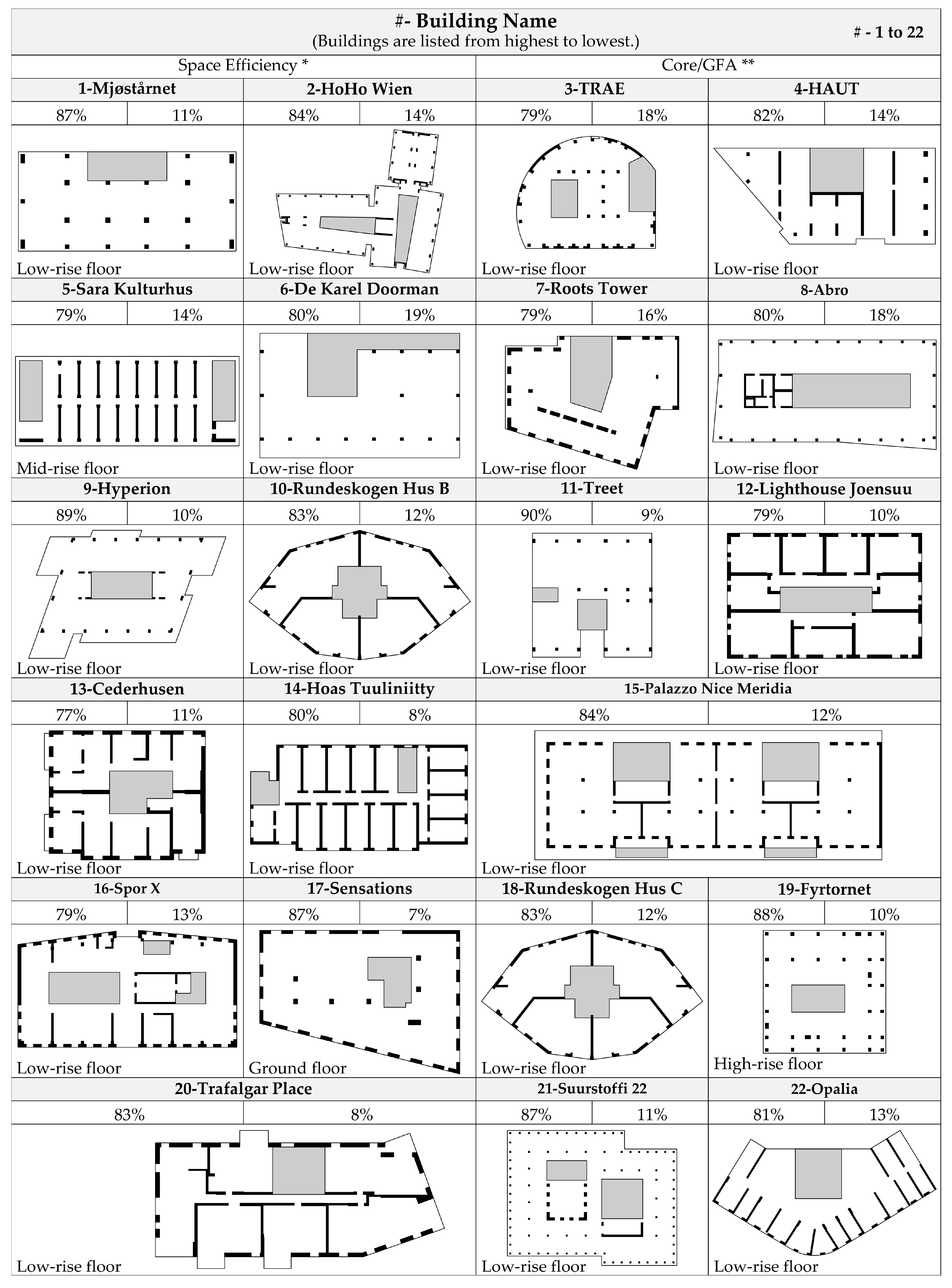
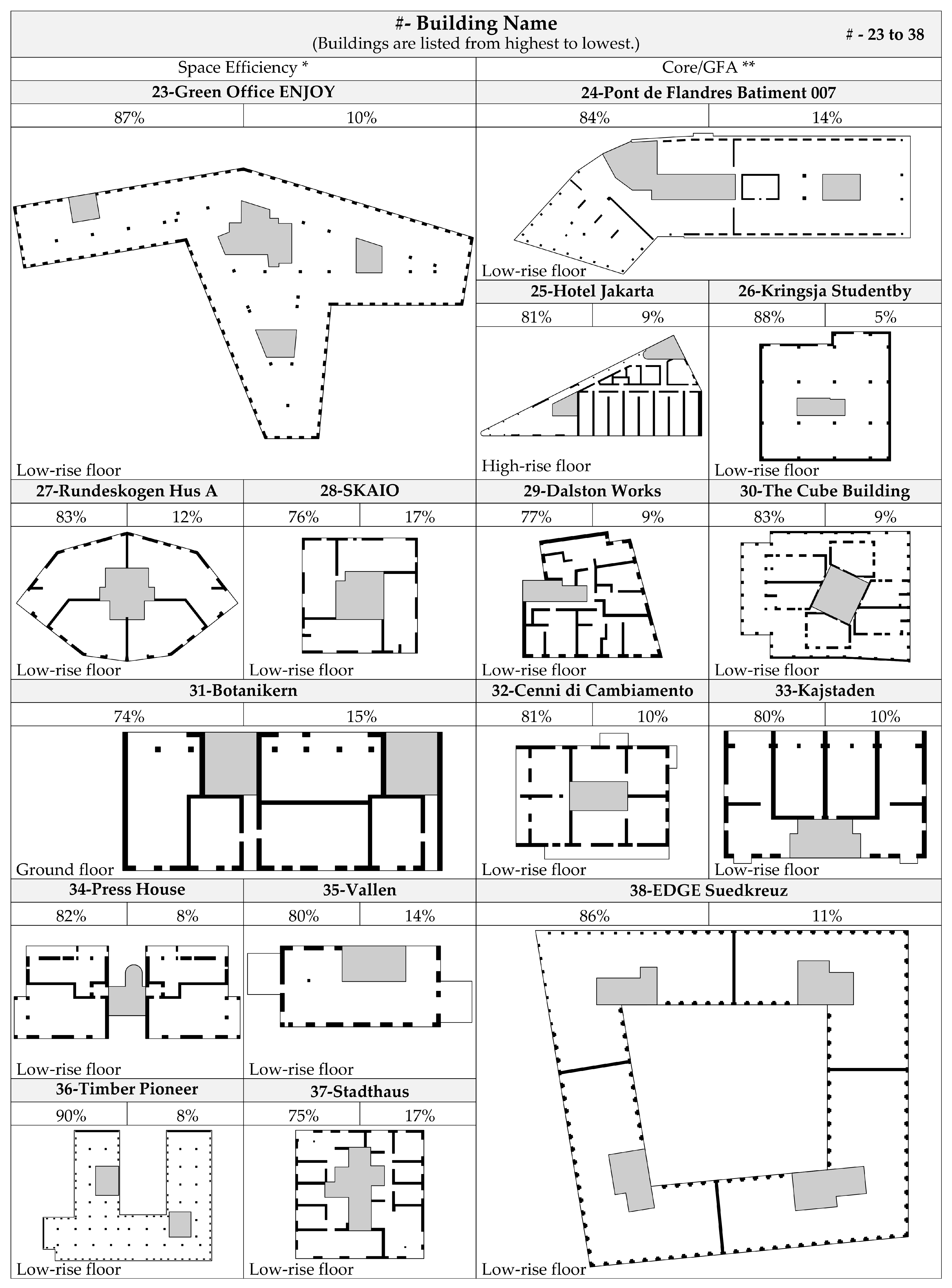
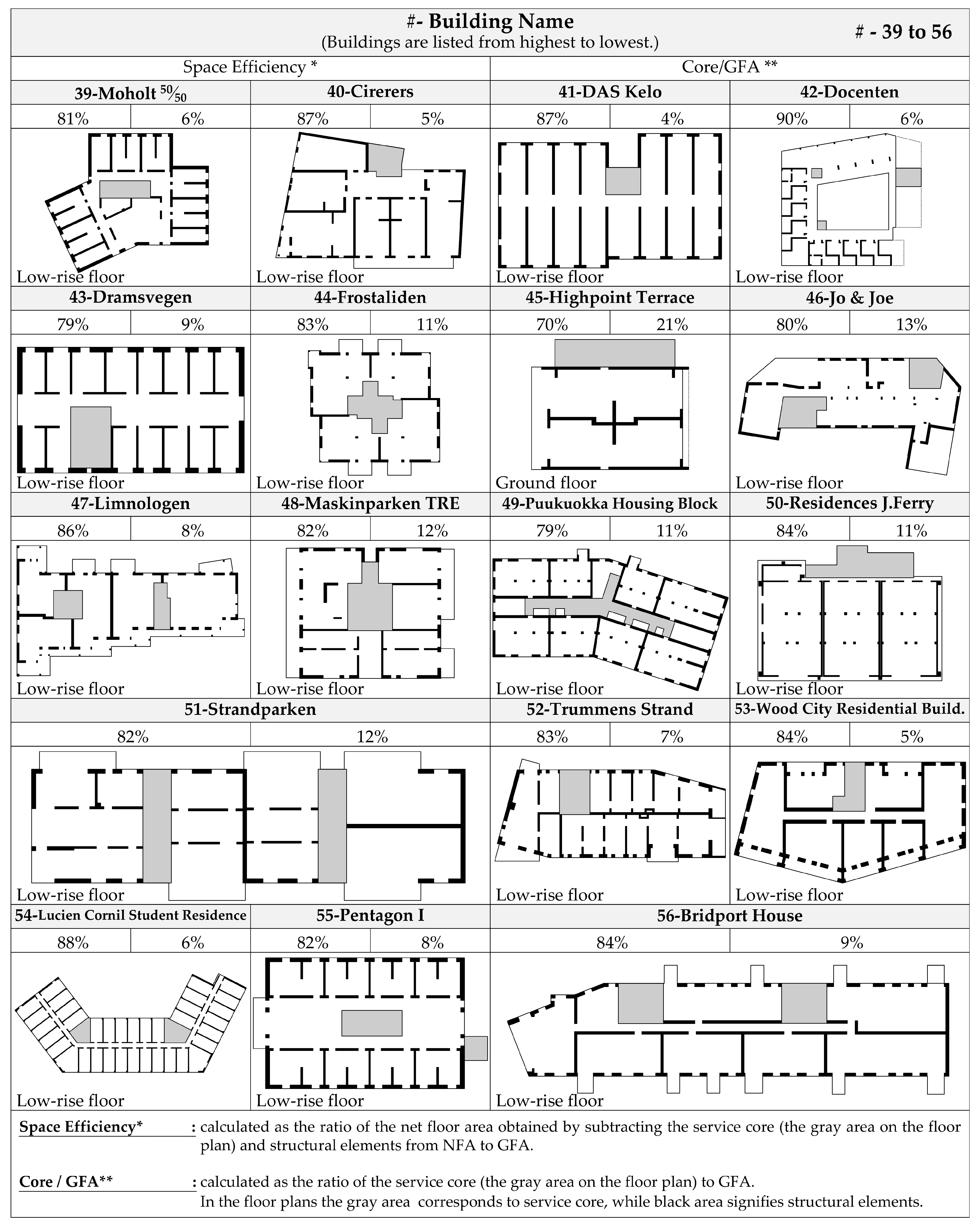
References
- Rahko, J.; Alola, A.A. Examining green productivity amidst climate change technological development and spillovers in the Nordic economies. J. Clean. Prod. 2024, 434, 140028. [Google Scholar] [CrossRef]
- Meena, C.S.; Kumar, A.; Jain, S.; Rehman, A.U.; Mishra, S.; Sharma, N.K.; Bajaj, M.; Shafiq, M.; Eldin, E.T. Innovation in green building sector for sustainable future. Energies 2022, 15, 6631. [Google Scholar] [CrossRef]
- Safarik, D.; Elbrecht, J.; Miranda, W. State of Tall Timber 2022. CTBUH J. 2022, 22–31. Available online: https://s3.eu-west-2.amazonaws.com/construo-storage/attachments/9a13793fe644586846b1b92c4901ae721325e3e88e4eb40b8e83a354c75d0d97/CTBUH%20-%20State%20of%20Tall%20Timber%202022,%20Issue%201.pdf (accessed on 29 June 2024).
- Morales-Beltran, M.; Engur, P.; Sisman, Ö.A.; Aykar, G.N. Redesigning for disassembly and carbon footprint reduction: Shifting from reinforced concrete to hybrid timber–steel multi-story building. Sustainability 2023, 15, 7273. [Google Scholar] [CrossRef]
- Laboy, M.M. Reimagining low-carbon futures: Architectural and ecological tradeoffs of mass timber for durable buildings. Archit. Struct. Constr. 2022, 2, 723–741. [Google Scholar] [CrossRef]
- Cavalli, A.; Togni, M. Monitoring of historical timber structures: State of the art and prospective. J. Civ. Struct. Health Monit. 2015, 5, 107–113. [Google Scholar] [CrossRef]
- Holzer, S.M. Analysis of historical timber structures. In Structural Analysis of Historical Constructions: Anamnesis, Diagnosis, Therapy, Controls; CRC Press: Boca Raton, FL, USA, 2016; pp. 1203–1210. [Google Scholar]
- Cruz, H.; Yeomans, D.; Tsakanika, E.; Macchioni, N.; Jorissen, A.; Touza, M.; Mannucci, M.; Lourenço, P.B. Guidelines for on-site assessment of historic timber structures. Int. J. Archit. Herit. 2015, 9, 277–289. [Google Scholar] [CrossRef]
- Le, V.A.; Nguyen, T.K.N. Discussion of So-Called “Architectural Heritage DNA” via a Case Study of the Conservation of the Nara Palace Site, Japan. Buildings 2024, 14, 132. [Google Scholar] [CrossRef]
- Cristea, I. Architecture of Estonia–old and new together. Urbanism. Arhitectură. Construcţii 2014, 5, 73–86. [Google Scholar]
- McKitterick, R.; Osborne, J.; Richardson, C.M.; Story, J. Old Saint Peter’s, Rome; Cambridge University Press: Cambridge, UK, 2013. [Google Scholar]
- Goubran, S.; Masson, T.; Walker, T. Diagnosing the local suitability of high-rise timber construction. Build. Res. Inf. 2020, 48, 101–123. [Google Scholar] [CrossRef]
- Ahn, N.; Dodoo, A.; Riggio, M.; Muszynski, L.; Schimleck, L.; Puettmann, M. Circular economy in mass timber construction: State-of-the-art, gaps and pressing research needs. J. Build. Eng. 2022, 53, 104562. [Google Scholar] [CrossRef]
- Zahiri, N. Timber High-Rises in Nordic Countries: Current Trends. CTBUH J. 2023, 44–50. Available online: https://www.proquest.com/openview/18bd24c28e7b2ef07815ea4e8423a3b6/1?pq-origsite=gscholar&cbl=6578554 (accessed on 29 June 2024).
- Hurmekoski, E.; Jonsson, R.; Nord, T. Context, drivers, and future potential for wood-frame multi-story construction in Europe. Technol. Forecast. Soc. Change 2015, 99, 181–196. [Google Scholar] [CrossRef]
- Vacek, Z.; Vacek, S.; Cukor, J. European forests under global climate change: Review of tree growth processes, crises and management strategies. J. Environ. Manag. 2023, 332, 117353. [Google Scholar] [CrossRef]
- Matiiuk, Y.; Krikštolaitis, R.; Liobikienė, G. The COVID-19 pandemic in context of climate change perception and resource-saving behavior in the European Union countries. J. Clean. Prod. 2023, 395, 136433. [Google Scholar] [CrossRef] [PubMed]
- Scouse, A.; Kelley, S.S.; Liang, S.; Bergman, R. Regional and net economic impacts of high-rise mass timber construction in Oregon. Sustain. Cities Soc. 2020, 61, 102154. [Google Scholar] [CrossRef]
- Liang, S.; Gu, H.; Bergman, R. Environmental life-cycle assessment and life-cycle cost analysis of a high-rise mass timber building: A case study in Pacific Northwestern United States. Sustainability 2021, 13, 7831. [Google Scholar] [CrossRef]
- Nepal, P.; Prestemon, J.P.; Ganguly, I.; Kumar, V.; Bergman, R.D.; Poudyal, N.C. The potential use of mass timber in mid-to high-rise construction and the associated carbon benefits in the United States. PLoS ONE 2024, 19, e0298379. [Google Scholar] [CrossRef] [PubMed]
- Arriaga, F.; Wang, X.; Íñiguez-González, G.; Llana, D.F.; Esteban, M.; Niemz, P. Mechanical Properties of Wood: A Review. Forests 2023, 14, 1202. [Google Scholar] [CrossRef]
- Ilgın, H.E. A study on space efficiency in contemporary supertall mixed-use buildings. J. Build. Eng. 2023, 69, 106223. [Google Scholar] [CrossRef]
- Ilgın, H.E. Space Efficiency in Contemporary Supertall Residential Buildings. Architecture 2021, 1, 25–37. [Google Scholar] [CrossRef]
- Ilgın, H.E. Space Efficiency in Contemporary Supertall Office Buildings. J. Archit. Eng. 2021, 27, 04021024. [Google Scholar] [CrossRef]
- Lin, C.L.; Chiang, W.H.; Weng, Y.S.; Wu, H.P. Assessing the anthropogenic carbon emission of wooden construction: An LCA study. Build. Res. Inf. 2023, 51, 138–157. [Google Scholar] [CrossRef]
- Karjalainen, M.; Ilgın, H.E.; Metsäranta, L.; Norvasuo, M. Wooden Facade Renovation and Additional Floor Construction for Suburban Development in Finland; IntechOpen: London, UK, 2022. [Google Scholar]
- Ilgın, H.E.; Karjalainen, M. Perceptions, Attitudes, and Interests of Architects in the Use of Engineered Wood Products for Construction: A Review; IntechOpen: London, UK, 2021. [Google Scholar]
- Jayawardana, J.; Kulatunga, A.K.; Jayasinghe, J.A.S.C.; Sandanayake, M.; Zhang, G. Environmental Sustainability of Off-Site Construction in Developed and Developing Regions: A Systematic Review. J. Archit. Eng. 2023, 29, 04023008. [Google Scholar] [CrossRef]
- Bahrami, A.; Jakobsson, J.; Söderroos, T. Factors Influencing Choice of Wooden Frames for Construction of Multi-Story Buildings in Sweden. Buildings 2023, 13, 217. [Google Scholar] [CrossRef]
- Balasbaneh, A.T.; Sher, W. Economic and environmental life cycle assessment of alternative mass timber walls to evaluate circular economy in building: MCDM method. Environ. Dev. Sustain. 2024, 26, 239–268. [Google Scholar] [CrossRef]
- Ascione, F.; Esposito, F.; Iovane, G.; Faiella, D.; Faggiano, B.; Mele, E. Sustainable and Efficient Structural Systems for Tall Buildings: Exploring Timber and Steel–Timber Hybrids through a Case Study. Buildings 2024, 14, 524. [Google Scholar] [CrossRef]
- Ghobadi, M.; Sepasgozar, S.M. Circular economy strategies in modern timber construction as a potential response to climate change. J. Build. Eng. 2023, 77, 107229. [Google Scholar] [CrossRef]
- Mamić, D.; Domljan, D. Positive Aspects of Using Solid Wood in Interiors on Human Wellbeing: A Review. Drv. Ind. 2023, 74, 379–391. [Google Scholar] [CrossRef]
- Loh, T.W.; Barnett, J.R.; Zhang, G.K.; Nguyen, K.T. Fire-Induced Damage and Postfire Analysis of the Compression Properties of Cross-Laminated Timber. J. Mater. Civ. Eng. 2024, 36, 04023595. [Google Scholar] [CrossRef]
- Ahmad, F.; Allan, K.; Phillips, A.R. Multicriteria decision analysis of steel and mass timber prototype buildings in the Pacific Northwest. J. Archit. Eng. 2023, 29, 04023001. [Google Scholar] [CrossRef]
- Ilgın, H.E.; Aslantamer, Ö.N. Analysis of Space Efficiency in High-Rise Timber Residential Towers. Appl. Sci. 2024, 14, 4337. [Google Scholar] [CrossRef]
- Aslantamer, Ö.N.; Ilgın, H.E. Space efficiency in timber office buildings. J. Build. Eng. 2024, 91, 109618. [Google Scholar] [CrossRef]
- Tuure, A.; Ilgın, H.E. Space Efficiency in Finnish Mid-Rise Timber Apartment Buildings. Buildings 2023, 13, 2094. [Google Scholar] [CrossRef]
- Ilgın, H.E.; Aslantamer, Ö.N. Investigating Space Utilization in Skyscrapers Designed with Prismatic Form. Buildings 2024, 14, 1295. [Google Scholar] [CrossRef]
- Ilgın, H.E. Space Efficiency in Tapered Super-Tall Towers. Buildings 2023, 13, 2819. [Google Scholar] [CrossRef]
- Ilgın, H.E. An analysis of space efficiency in Asian supertall towers. Int. J. Build. Pathol. Adapt. 2023, 41, 237–253. [Google Scholar] [CrossRef]
- Ilgın, H.E. Examination of spatial efficiency in super-tall towers within the Middle Eastern context. Open House Int. 2024; ahead-of-print. [Google Scholar] [CrossRef]
- Okbaz, F.T.; Sev, A. A model for determining the space efficiency in non-orthogonal high rise office buildings. J. Fac. Eng. Archit. Gazi Univ. 2023, 38, 113–125. [Google Scholar]
- Ibrahimy, R.; Mohmmand, M.A.; Elham, F.A. An Evaluation of Space Use Efficiency in Residential Houses, Kabul City. J. Res. Appl. Sci. Biotechnol. 2023, 2, 1–6. [Google Scholar] [CrossRef]
- Goessler, T.; Kaluarachchi, Y. Smart Adaptive Homes and Their Potential to Improve Space Efficiency and Personalisation. Buildings 2023, 13, 1132. [Google Scholar] [CrossRef]
- Hamid, G.M.; Elsawi, M.; Yusra, O. The Impacts of Spatial Parameters on Space Efficiency in Hybrid Villa-Apartments in Greater Khartoum, Sudan. J. Archit. Plan. 2022, 34, 425–440. [Google Scholar]
- Suga, R. Space Efficiency in Hotel Development. Master’s Thesis, MODUL University Vienna, Vienna, Austria, 2021. [Google Scholar]
- Arslan Kılınç, G. Improving a Model for Determining Space Efficiency of Tall Office Buildings. Ph.D. Thesis, Department of Architecture, Mimar Sinan Fine Art University, Istanbul, Turkey, 2019. (In Turkish). [Google Scholar]
- Von Both, P. A stakeholder-and function-based planning method for space-efficient buildings. IOP Conf. Ser. Earth Environ. Sci. 2019, 323, 012040. [Google Scholar] [CrossRef]
- Höjer, M.; Mjörnell, K. Measures and steps for more efficient use of buildings. Sustainability 2018, 10, 1949. [Google Scholar] [CrossRef]
- Nam, H.J.; Shim, J.H. An analysis of the change in space efficiency based on various tall building corner shapes and lease spans. J. Archit. Inst. Korea Plan. Des. 2016, 32, 13–20. [Google Scholar]
- Zhang, L.; Zhang, L.; Wang, Y. Shape optimization of free-form buildings based on solar radiation gain and space efficiency using a multi-objective genetic algorithm in the severe cold zones of China. Sol. Energy 2016, 132, 38–50. [Google Scholar] [CrossRef]
- Sev, A.; Özgen, A. Space efficiency in high-rise office buildings. METU J. Fac. Archit. 2009, 26, 69–89. [Google Scholar] [CrossRef]
- Saari, A.; Tissari, T.; Valkama, E.; Seppänen, O. The effect of a Redesigned Floor Plan, Occupant Density and the Quality of Indoor Climate on the Cost of Space, Productivity and Sick Leave in an Office Building—A Case Study. Build. Environ. 2006, 41, 1961–1972. [Google Scholar] [CrossRef]
- Kim, H.; Elnimeiri, M. Space efficiency in multi-use tall building. In Proceedings of the Tall Buildings in Historical Cities-Culture and Technology for Sustainable Cities, Seoul, Republic of Korea, 10–13 October 2004. [Google Scholar]
- CTBUH Council on Tall Buildings Urban Habitat Illinois Institute of Technology, S.R. Crown Hall, 3360 South State Street, Chicago, IL, USA. Available online: https://www.ctbuh.org (accessed on 14 June 2024).
- Opoku, A.; Ahmed, V.; Akotia, J. Choosing an Appropriate Research Method. In Research Methodology in the Built Environment; Routledge: London, UK, 2016; pp. 32–49. [Google Scholar]
- Noor, K.B.M. Case study: A strategic research methodology. Am. J. Appl. Sci. 2008, 5, 1602–1604. [Google Scholar] [CrossRef]
- Ali, M.M.; Moon, K.S. Advances in Structural Systems for Tall Buildings: Emerging Developments for Contemporary Urban Giants. Buildings 2018, 8, 104. [Google Scholar] [CrossRef]
- Taranath, B.S. Structural Analysis and Design of Tall Buildings: Steel and Composite Construction; CRC Press: Boca Raton, FL, USA, 2016. [Google Scholar]
- Ali, M.M.; Al-Kodmany, K. Structural Systems for Tall Buildings. Encyclopedia 2022, 2, 1260–1286. [Google Scholar] [CrossRef]
- Li, S.; Shao, Y.; Hong, M.; Zhu, C.; Dong, B.; Li, Y.; Lin, Y.; Wang, K.; Gan, M.; Zhu, J.; et al. Impact mechanisms of urbanization processes on supply-demand matches of cultivated land multifunction in rapid urbanization areas. Habitat Int. 2023, 131, 102726. [Google Scholar] [CrossRef]
- Tupenaite, L.; Kanapeckiene, L.; Naimaviciene, J.; Kaklauskas, A.; Gecys, T. Timber construction as a solution to climate change: A systematic literature review. Buildings 2023, 13, 976. [Google Scholar] [CrossRef]
- Ojala, A.; Kostensalo, J.; Viik, J.; Matilainen, H.; Wik, I.; Virtanen, L.; Muilu-Mäkelä, R. Psychological and physiological effects of a wooden office room on human well-being: Results from a randomized controlled trial. J. Environ. Psychol. 2023, 89, 102059. [Google Scholar] [CrossRef]
- Oldfield, P.; Doherty, B. Offset Cores: Trends, Drivers and Frequency in Tall Buildings. CTBUH J. 2019, 40–45. Available online: https://global.ctbuh.org/resources/papers/download/4186-offset-cores-trends-drivers-and-frequency-in-tall-buildings.pdf (accessed on 14 June 2024).
- Nehdi, M.L. Only tall things cast shadows: Opportunities, challenges and research needs of self-consolidating concrete in super-tall buildings. Constr. Build. Mater. 2013, 48, 80–90. [Google Scholar] [CrossRef]
- Szolomicki, J.; Golasz-Szolomicka, H. Technological advances and trends in modern high-rise buildings. Buildings 2019, 9, 193. [Google Scholar] [CrossRef]
- James, M. Twisted, Tapered, Tilted (Leaning) Towers: Structural Complexities & Advantages. Int. J. Innov. Res. Adv. Stud. (IJIRAS) 2017, 4, 78–83. [Google Scholar]
- Demirel, G.N.; Ay, B.Ö. A comparative study on structural design alternatives for twisted tall buildings with outriggers. Archit. Sci. Rev. 2022, 65, 436–448. [Google Scholar] [CrossRef]
- Pastori, S.; Mazzucchelli, E.S.; Wallhagen, M. Hybrid timber-based structures: A state of the art review. Constr. Build. Mater. 2022, 359, 129505. [Google Scholar] [CrossRef]
- Shin, B.; Kim, S. Advancing the circular economy and environmental sustainability with timber hybrid construction in South Korean public building. Build. Environ. 2024, 257, 111543. [Google Scholar] [CrossRef]
- Zhang, X.; Huang, W.; Khajehpour, M.; Asgari, M.; Tannert, T. Seismic Performance and LCA Comparison between Concrete and Timber–Concrete Hybrid Buildings. Buildings 2023, 13, 1714. [Google Scholar] [CrossRef]
- Altaher Omer Ahmed, A.; Garab, J.; Horváth-Szováti, E.; Kozelka, J.; Bejó, L. The Bending Properties of Hybrid Cross-Laminated Timber (CLT) Using Various Species Combinations. Materials 2023, 16, 7153. [Google Scholar] [CrossRef] [PubMed]
- Wang, W. Research on seismic design of high-rise buildings based on framed-shear structural system. Front. Res. Archit. Eng. 2020, 3, 87–90. [Google Scholar] [CrossRef]
- Dias, A.M.P.G.; Skinner, J.; Crews, K.; Tannert, T. Timber-concrete-composites increasing the use of timber in construction. Eur. J. Wood Wood Prod. 2016, 74, 443–451. [Google Scholar] [CrossRef]
- Hanták, J.; Končeková, D. Positive effects of wood in Vorarlberg’s (Austria) timber kindergartens. Archit. Pap. Fac. Archit. Des. STU 2023, 28, 36–49. [Google Scholar] [CrossRef]
- Dharanidharan, K.; Selvanayaki, S.; Divya, K.; Ravikumar, R.; Raj, S.V. Exploring Household Wood Preferences among Consumers in Coimbatore. Asian J. Agric. Ext. Econ. Sociol. 2023, 41, 196–203. [Google Scholar] [CrossRef]
- Yeang, K. Service Cores: Detail in Building; Wiley-Academy: London, UK, 2000. [Google Scholar]
- Abed, J.; Rayburg, S.; Rodwell, J.; Neave, M. A Review of the Performance and Benefits of Mass Timber as an Alternative to Concrete and Steel for Improving the Sustainability of Structures. Sustainability 2022, 14, 5570. [Google Scholar] [CrossRef]
- Caniato, M.; Marzi, A.; da Silva, S.M.; Gasparella, A. A review of the thermal and acoustic properties of materials for timber building construction. J. Build. Eng. 2021, 43, 103066. [Google Scholar] [CrossRef]
- Ramage, M.H.; Burridge, H.; Busse-Wicher, M.; Fereday, G.; Reynolds, T.; Shah, D.U.; Wu, G.; Yu, L.; Fleming, P.; Densley-Tinglet, D.; et al. The wood from the trees: The use of timber in construction. Renew. Sustain. Energy Rev. 2017, 68, 333–359. [Google Scholar] [CrossRef]
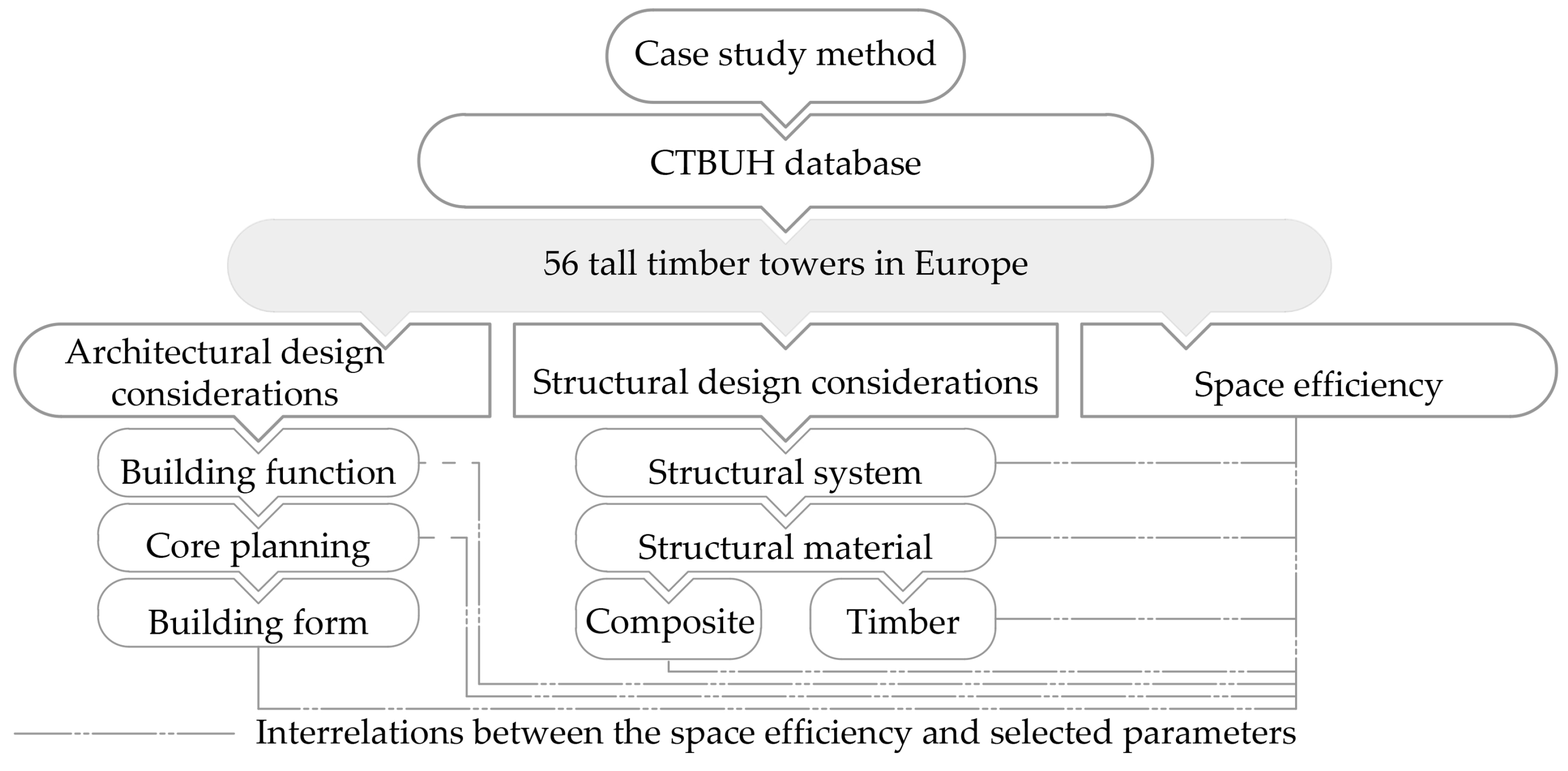
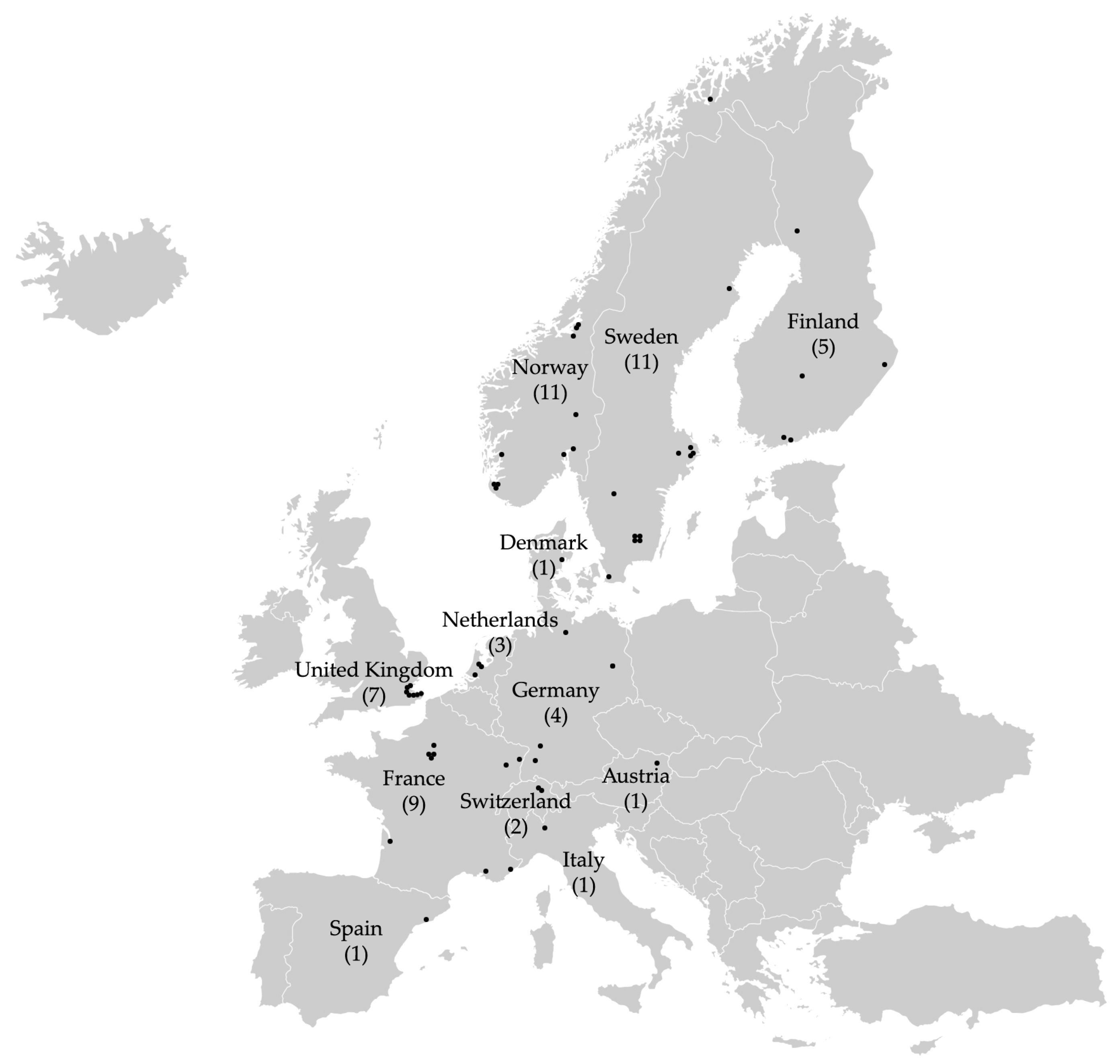




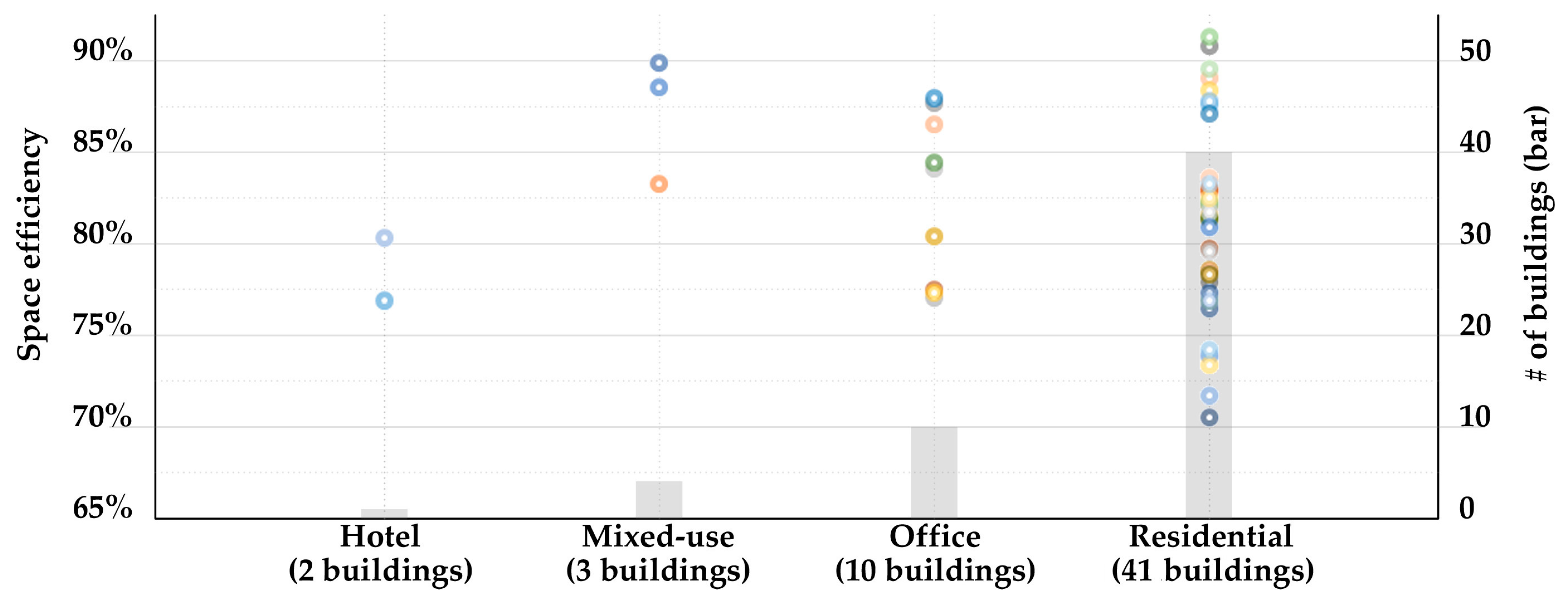
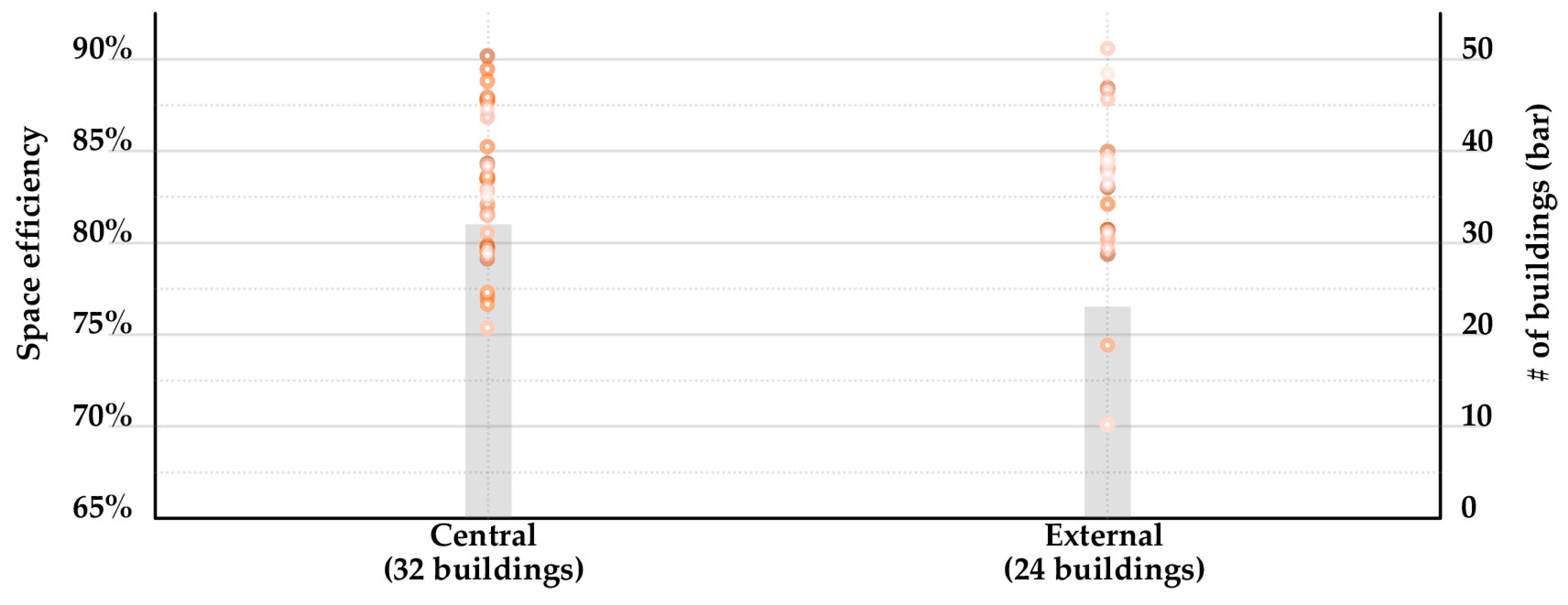



| The Findings | Asian Skyscrapers (75 Cases) | Middle Eastern Skyscrapers (27 Cases) | |
|---|---|---|---|
| Average space efficiency | 82% (max. 90%, min. 70%) | 67.5% (max. 82%, min. 56%) | 75.5% (max. 84%, min. 63%) |
| Average ratio of core to GFA | 11% (max. 21%, min. 4%) | 29.5% (max. 38%, min. 14%) | 21.3% (max. 36%, min. 11%) |
Disclaimer/Publisher’s Note: The statements, opinions and data contained in all publications are solely those of the individual author(s) and contributor(s) and not of MDPI and/or the editor(s). MDPI and/or the editor(s) disclaim responsibility for any injury to people or property resulting from any ideas, methods, instructions or products referred to in the content. |
© 2024 by the authors. Licensee MDPI, Basel, Switzerland. This article is an open access article distributed under the terms and conditions of the Creative Commons Attribution (CC BY) license (https://creativecommons.org/licenses/by/4.0/).
Share and Cite
Ilgın, H.E.; Aslantamer, Ö.N. Space Efficiency in European High-Rise Timber Buildings. Appl. Sci. 2024, 14, 5838. https://doi.org/10.3390/app14135838
Ilgın HE, Aslantamer ÖN. Space Efficiency in European High-Rise Timber Buildings. Applied Sciences. 2024; 14(13):5838. https://doi.org/10.3390/app14135838
Chicago/Turabian StyleIlgın, Hüseyin Emre, and Özlem Nur Aslantamer. 2024. "Space Efficiency in European High-Rise Timber Buildings" Applied Sciences 14, no. 13: 5838. https://doi.org/10.3390/app14135838
APA StyleIlgın, H. E., & Aslantamer, Ö. N. (2024). Space Efficiency in European High-Rise Timber Buildings. Applied Sciences, 14(13), 5838. https://doi.org/10.3390/app14135838









